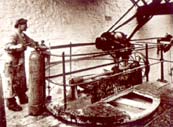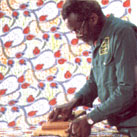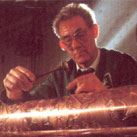The Wax Print is based on the Javanese batik print that was introduced to West Africa during the second half of the 19th Century. African soldiers, returning home after serving commissions in Indonesia, took these brightly coloured cloths with them and soon started a fashion in their own countries. Small local production started but demand exceeded supply because the traditional production process was slow and laborious. Several European manufacturers, including ABC, began experimenting to speed up the process in order to produce this cloth at more affordable prices.
 |
The first ABC Wax Prints were produced in 1908 on the same site as today, which was constructed in 1812 as a conventional textile printing factory.
These photographs were taken in 1926. |
 |
Wax process
A Wax Print starts with the design. ABC designers constantly searched for new ideas, travelling to Africa and talking with customers and distributors. The African influence was of paramount importance in a design, but the design itself was usually created in the UK. New designs were launched at the rate of about 200 per year.
When a customer chose a particular design, that design was engraved on a pair of copper rollers. Printing a resin paste - hence the term "Wax" - on to both sides of the cotton cloth creates the Wax Print. The cloth was then dyed - either in Indigo or the now more popular Royal Blue - and the design appears on those areas of the cloth where the resin has not been applied. The cloth was then treated mechanically to produce the cracking effect, characteristic of a real Wax Print. Depending on the type and duration of this process, different effects of marbling in the colour could be achieved. Further colours could be added whilst the cracked resin remained on the cloth, and then again after all the resin had been removed. It was this combination of cracking, marbled colours and solid colours that illuminated the ABC Wax Print to such a fine degree.

![]()
![]()

![]()
![]()

Continued emphasis on developing new styles and colours had not altered the unique characteristic that each yard of ABC Wax was different and beautiful. Concentrating on innovative designs, brightness of colours and quality of cloth, ABC provided the most attractive range of wax prints available on the market.
The Cha Group
ABC is part of the Cha Group of companies. Technical liaison with the many textile mills in West Africa and access to the extensive network of distributors had been a major strength.
The Cha Group has earned its identity as the most cost-effective and dependable source of African textile products, through fifty years' successful operation. They established a unique reservoir of skill and technology, with a depth of experienced management, unmatched in West Africa or indeed elsewhere.
About 20,000 people were employed - the vast majority in Africa. The Group held the major market share of the Wax print market.
Move to Ghana
On December 21st , 2005, His Excellency, President John A. Kufour officially inaugurated ABC's new production facility at our sister company, Akosombo Textiles Limited. Our decision to move production of standard wax to Ghana was based on the need to respond more quickly to the changing demands of the local African consumer.
This move took years of planning and an investment worth millions of dollars. New machinery was installed at the Akosombo site and the workforce were highly trained by ABC technical managers so that ABC's high production standards were maintained.
The success of producing high quality Standard wax in Ghana during 2006/7, led to the transfer of the remaining ABC products such as Superwax, Handblock and Premium which resulted in the final closure of the Manchester production facility in December 2007.
To maintain and protect the ABC brand and products, a small design studio was retained in Manchester, until February 2021, when the Manchester studio was finally closed.
![]()
